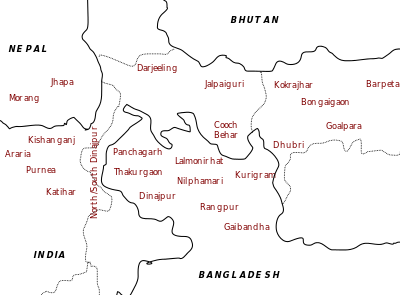Kamatapuri lects

Kamatapuri lects are a group of modern lects (also called KRNB lects short for Kamta, Rajbanshi and Northern Deshi Bangla)[2] that are associated with the proto-Kamta language that developed in North Bengal after 1255.[3]
Origin
The development of proto-Kamta was the result of Sandhya, a ruler of Kamarupanagara (Guwahati), Kamrup moving his capital[4] to Kamata and establishing the Kamata kingdom.
Linguistic area
The Kamatapuri lects are spoken primarily in Goalpara region of Assam, North Bengal, Eastern Bihar and Eastern Nepal (see map).
Kamrupi
The modern Bengali scholars like Suniti Kumar Chatterjee and Sukumar Sen[5] have named the dialect of Bengali spoken in North Bengal as Kamrupi. Chatterjee writes, Assamese Kamrupi and Bengali Kamrupi is quite similar, the division possibly occurred due to political reasons and two forms dialect continuum.[6][7] According to him, Magadhi Prakrit, keeping north of the Ganga river, gave rise to the Kamarupa Apabhramsa dialects of Western Assam and North Bengal. Chatterjee divides Magadhan dialects regionwise as Radha, Varendra, Kamarupa[8] and Vanga [9][10]
Notes
- ↑ (Toulmin 2006, p. 5)
- ↑ (Toulmin 2006, p. iv)
- ↑ (Toulmin 2006, p. 283)
- ↑ (Toulmin 2006, p. 282)
- ↑ "Kamrupi". banglapedia.org. Retrieved 2012-08-11.
- ↑ Sukhabilasa Barma, Bhawaiya, ethnomusicological study,2004 Based on the materials of the Linguistic Survey of India, Suniti Kumar Chattopadhyay has divided Eastern Magadhi Prakrita and Apabhramsa into four dialect groups (1) Radha-the language of West Bengal and Orissa (2) Varendra-dialect of North Central Bengal (3) Kamrupi-dialect of Northern Bengal and Assam and (4) Vanga-dialect of East Bengal.
- ↑ Sukhabilasa Barma, Bhawaiya, ethnomusicological study, 2004 Acharya Suniti Chattopadhyay has commented that Assam was practically an extension of North Bengal, from its geographical position, so far as its speech and early history were concerned'.
- ↑ Suniti Kumar Chatterji (1926), The origin and development of the Bengali language, Volume 1 One would expect one and identical language to have been current in North Central Bengal (Pundra-vardhana) and North Bengal and West Assam (Kamarupa) in the 7th century, since these tracts, and other parts of Bengal, had almost the same speech
- ↑ Suniti Kumar Chatterji, The origin and development of the Bengali language, Volume 1 Eastern Magadhi Prakrita and Apabhramsa has four dialect groups (1) Radha-the language of West Bengal and Orissa (2) Varendra-dialect of North Central Bengal (3)Kamarupa-dialect of Northern Bengal and Assam and (4) Vanga-dialect of East Bengal.
- ↑ (Chatterji 1970, p. 140)
References
- Toulmin, Mathew W S (2006). Reconstructing linguistic history in a dialect continuum: The Kamta, Rajbanshi, and Northern Deshi Bangla subgroup of Indo-Aryan (Ph.D.). The Australian National University.